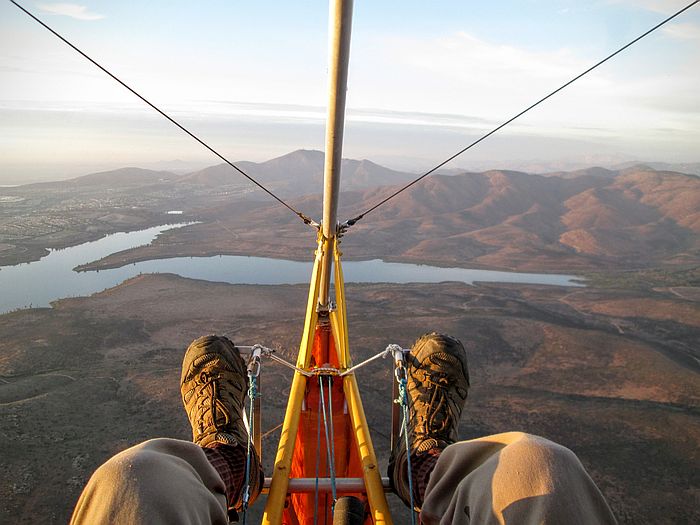
Motorfloater
Storyboard 2
|
By Mike Sandlin 28 July 2023 |
 |
Fair weather flying is what you do
in a motorfloater. It's comfortable, but noisy. When I started
using a good set of headphones, which were supposed to have a
noise reduction function, it was a substantial improvement.
Sometimes
it suddenly gets warmer as I climb into a stabilized layer of
air. I usually wear a jacket I can un-zipper when I get too
warm. On occasion I'd like to take my jacket off in flight, but
I haven't done it, that would be rather daring (I don't want to
get stuck in some awkward body position while unable to reach
the control stick) and I have no good place to put the jacket
once I get it off (it must not get loose and get sucked into the
prop). Dressing too warm is not usually a problem, anyway.
I tour the local area, just
looking at whatever I find. In calm air I might be
spiraling down and suddenly get solidly bumped by flying through
my own wake. This can be alarming, it makes you look around for
whatever it was that came close but was unseen, when, of course,
there was nothing there at all.
|
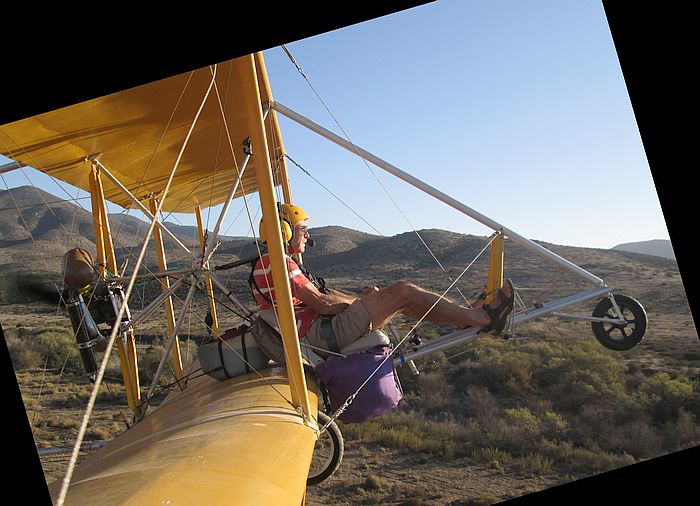 |
Here's a nose up climb,
"clawing" for altitude in the traditional two-stroke engine
mode. The idea was to get up fast in case the engine quit so
you would have some emergency landing options. This high a
nose attitude might not be giving me my best climb angle, but
I did seem to be going up, so I wasn't just wallowing on the
back side of the power curve. At full power and full back
stick the plane won't do a nose drop, it just keeps flying, so
I can indulge myself in delusions of ascendance. This might
not be true for heavier pilots, considering that the pilot is
half the gross weight of a motorfloater. Adding fifty pounds
might not be trivial.
If the engine stopped at low altitude I would put the nose down (to get extra airspeed, for good flight control), focus on flying the airplane (ignoring distractions), and make a plan for a simple landing (avoiding low turns or close proximity). I would not try to re-start the engine (it might not work) and I would not call the tower to declare an emergency (they'll figure it out). I wouldn't make any big effort to preserve the aircraft, I'd concentrate on pilot safety (me) and avoid pointing the nose at anything valuable.
|
|
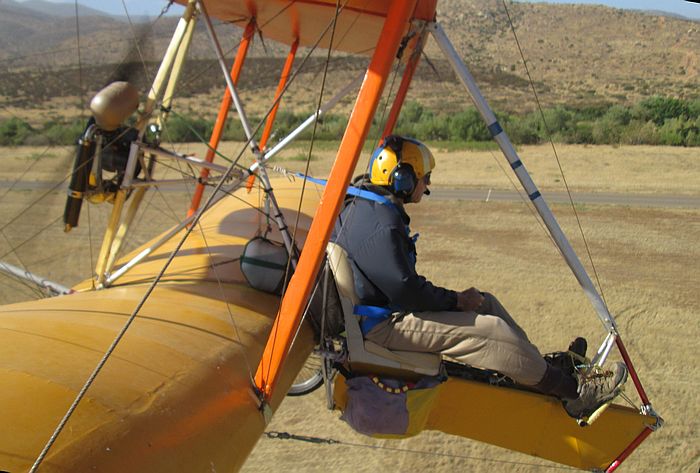 |
With
the power at idle, the Bloop trims nose down and wants to go
fast. For landing I usually have to hold back a little on the
stick to keep it at a slower approach speed. If I get down into
ground skim going fast then use up a lot of runway doing a
delayed touch down.
|
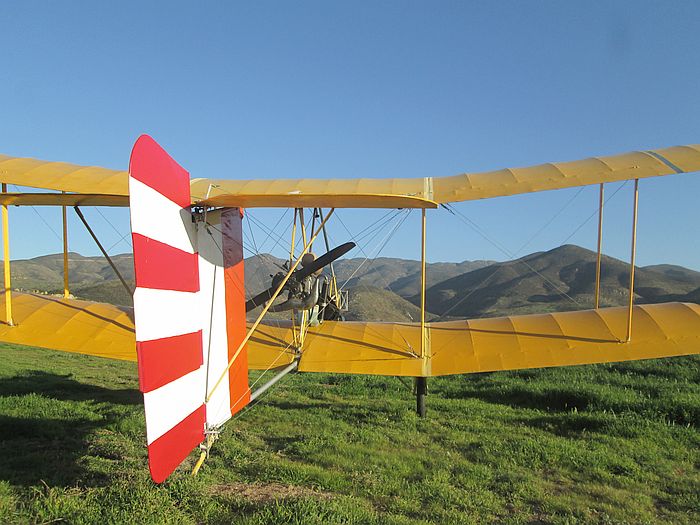 |
Some
pilots
might dismiss a plane for being too draggy, having too many
struts and cables strung out across the breeze.
Exposed
struts and cables are draggy, but so what? Parasite drag will
reduce your top speed and climb rate, but those need not be of
high importance to a motorfloater. The effect of drag on local
flying at slow speeds is: not much, since you are there to
fly, not to go fast or far. Climb angle can be a safety issue
with airplanes that cannot turn sharply, they may have to go
over obstacles when a motorfloater might just make a tight
turn back into the clear airspace they just flew
through.
|
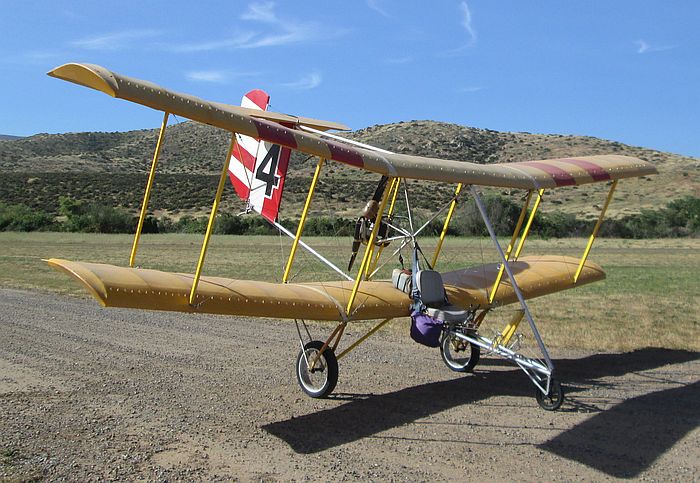 |
The nose down landing is a safety feature that is intended to allow the pilot to land the plane in a strong wind. Once the plane stops, nose down, it can be held in place to allow the pilot to get out. In normal conditions, the pilot can choose to stop
tail down or nose down on any flight. Use the nose down stop
if you need a ground brake (the tail skid is not impressive),
it also makes getting out easier. Take offs are made starting
with the tail down. The "always on" nose wheel ground brake is
too effective to allow a take off.
Full span vortex generators were applied to both the
upper and lower wings of Bloop 4. Here they look like a row of
small bumps from wing tip to wing tip on the tops of the
wings. They worked as advertised, allowing smoother, better
controlled slow flight and having no evident effects at higher
speeds. They may have allowed slower flight, and they seemed
to prolong floating in ground effect when landing. On the
Bluebird monoplane I didn't use them because I didn't want a
long float over the runway before setting down onto the
ground.
|
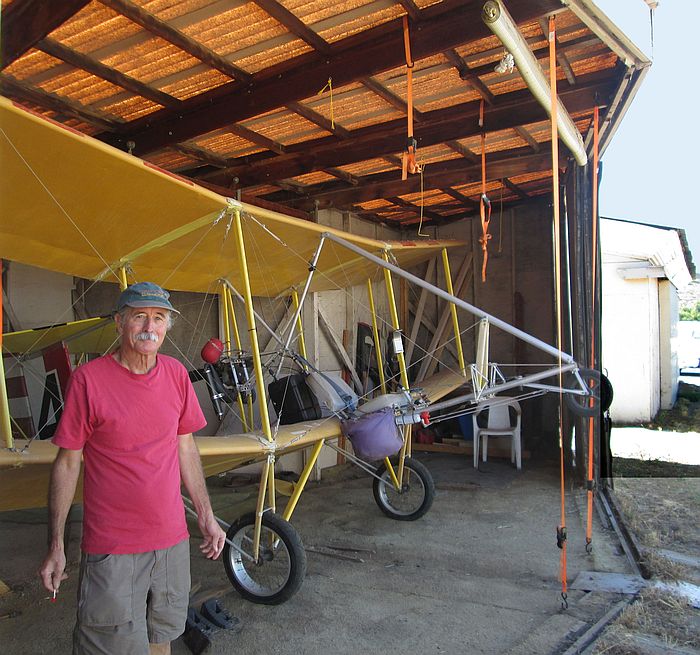 |
Here's Floyd Fronius with Bloop 4
in his rustic hangar.
The previous operator has installed a 5 gallon fuel tank, that black box on top of the lower wing. Several Bloop operators have done something like this, bringing the plane up to the full Part 103 allowable fuel capacity, and allowing long flights with a good margin of reserve fuel. I still prefer the original 2.5 gallon tank, it's the right size for local flights and keeps you from flying with 15 pounds of unused gas. Also, I really like the translucency of the smaller tank, I can quickly see how full it is. As
of July 2023 Bloop 4 has a new owner and is flying in
southern California with the original small fuel tank and
a new tail skid.
|
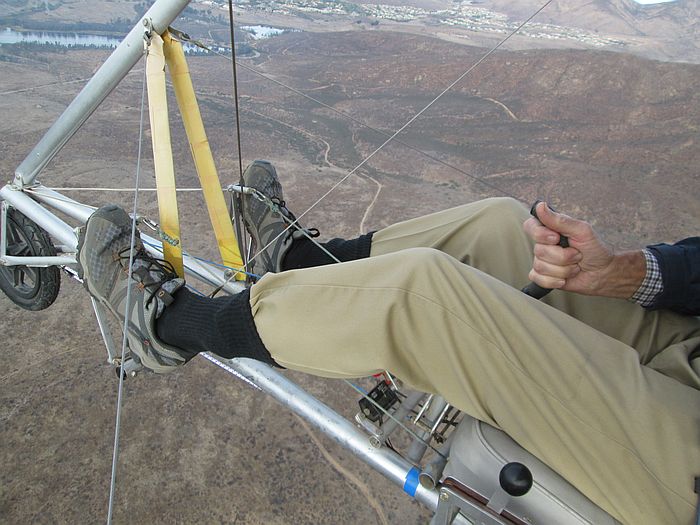 |
A lot of garage technology is in view here . Anything
that is damaged can be quickly replaced or repaired, either by
work in my shop or by an "off the shelf " purchase.
This control system is intended to be as close as I can get to the conventional airplane system. The foot pedals command the rudder (yaw), and the fore and aft stick position commands the elevator (pitch). Throttle motion conforms to convention: black knob all the way forward is full power and way back is idle. I get some humorous comments about using clothesline for control cables, which I don't, of course. That's synthetic marine blended line that's stronger (even when knotted) than the usual 1/16 in.braided steel cable. This is modern synthetic line which is stiff and does not creep (does not elongate from usage). An elegant fashion statement for spring flying includes drag reducing socks over pant cuffs |
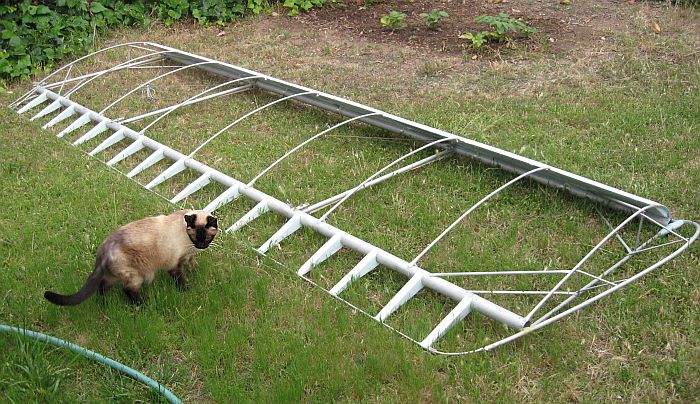 |
This wing structure is ready for fabric covering.
Each rib is just a tube on the upper surface, there is no rib
structure below that. The lower surface fabric is tensioned by
being drawn upward using loops of stitching over the rib
tube.The undercamber of the lower surface is incidental, it's
just a result of tensioning the fabric.
My motorfloaters don't have welding, sheet metal, structural riveting, jigs or molds, spray painting, wood, windows, windshields, doors, walls, electrical or hydraulic systems, nor flight instruments. There is no circulation of water or oil, no dual ignition checks, no fuel valve, no fuel sample drain check, no ground steering system, no tail wheel, no main wheel brakes, no pyrotechnic rocket expiration date, and no access doors to open and close. My
current practice is not to bend any tubes larger than 1/2
inch diameter. I used to do this but I came to see it as a
"special skill" which could be eliminated. Garage technology
involves a minimum skill set and no specialized vendor parts
or support. |
 |
Beach
wheels! I flew with these slick balloon tires for a while and I
liked them the most of all, more than the bicycle or kite buggy
tires. They were soft and bouncy, and would skid sideways
without much resistance (which I liked a lot). This property of
weak side loads in response to a side skid puts less load on the
landing gear when landing at a crab angle, and probably gives
better steering control. (Crab angle means my course is down the
runway but my heading is pointing off into the crosswind, so I
touch down slightly sideways. Wheel dance!). I suppose most
airplanes want strong tire tracking forces to keep the plane
straight on the runway, but I want the opposite, the weakest
possible tracking so I can slide a little.
These were big, fat wheels (19.3" x 9"). On final glide to landing at low power I noticed a steeper descent than with the bike tires, a noticeable increase in drag. |
|
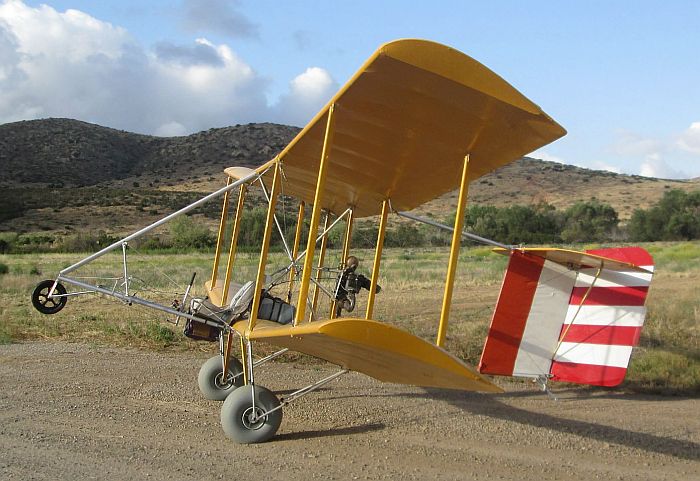 |
The
beach tires are cute and fun to fly with, but they are just
light urethane tubes and not very durable, so I doubt they would
last long on runways. Durable balloon tires, with tubes, tend to
be heavy, but these beach tires suggest they might be a lot of
fun to fly with.
I was
operating from fields with nasty thorns that often punctured the
tires. Even while using bicycle-type puncture sealing slime
inside the tires I was having to add air on every flying day,
and that seemed too high a maintenance burden. Eventually
I returned to using heavier, more conventional wheels.
FAA Part 103 has provided us with a golden era of experimental flight. I have taken full advantage of it's freedoms for design, construction, modification,and test flying. I flew experiments with variations of wheels, controls, nose structure, nose and tail skids, ground brakes, parachute containers, line tensioning, wing angle and twist, rudder and horizontal tail plane shapes, and various ways of building foot pedals. |
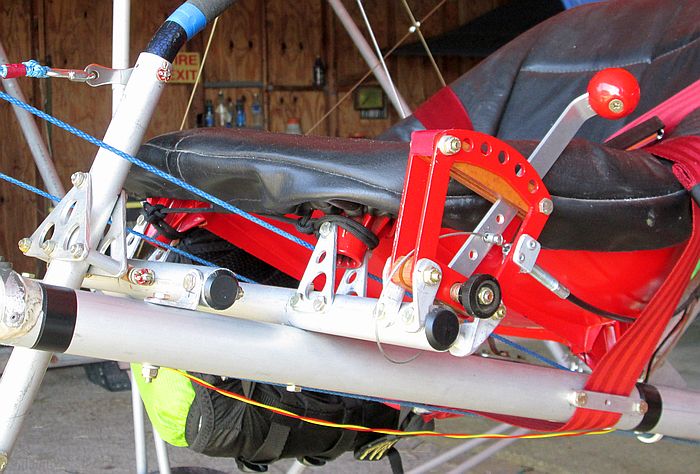 |
The "off the shelf" (then stylized) ultralight
throttle quadrant uses
an adapted go kart throttle cable to control engine speed.
The seat belts are four point (lap and shoulder belts) automotive type with a push button release, which I prefer to the aircraft belts because they are less tricky and not as quick to release. The seat itself is a molded polypropylene bar stool with a padded cover. Previously I had used folding boat seats, which are more comfortable but not as easy to secure nor as strong. The boat seat frames would break up without a lot of custom re-enforcement. The
tubes were cut with a hacksaw, the holes were made with a hand
held power drill, smoothing was done with a file. I have a 4"
vice and a work table, I don't use a drill press and rarely
use a grinder.
|
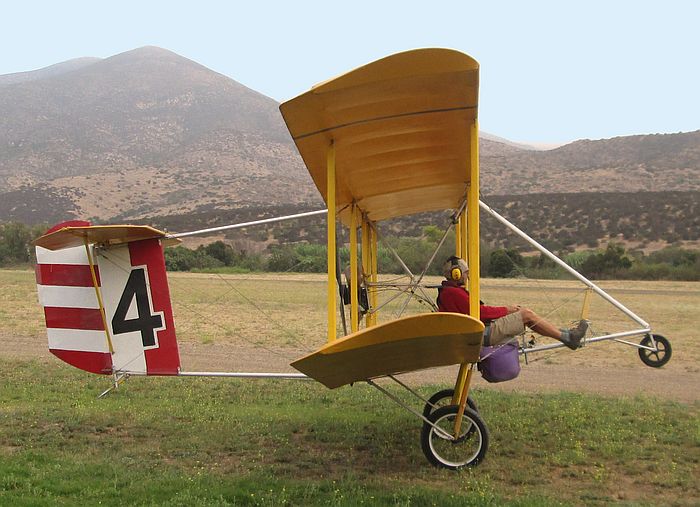 |
I'm
in the Bloop at full throttle, going nowhere because there is a
long line tied to my tail anchoring me to the ground (too small
to see in the picture, unfortunately). This is tethered
operation, which allows me to experience the feel, sound, and
control effects of flight without going anywhere, kind of like a
Bloop turned into a stationary amusement park ride. Even with no
wind, the propwash on the tail allows me to maneuver in pitch
and yaw while using the throttle realistically.
This might be a good start to a training or transition program, you can get used to operating the controls while just sitting there. The next stage would be scooting on the ground, followed by hops down the runway. With rudder only steering there is no transition to coordinated flight once in the air, the steering is the same as on the ground. The big difference in the air is that the plane will now bank as well as yaw around the turns. My
motorfloaters are neither tail draggers nor nose draggers, if
anything they are neutral draggers, because the main wheels are
at the center of lift, not way forward or aft. This makes the
static balance close to neutral on the ground, favoring tethered
operation.
|